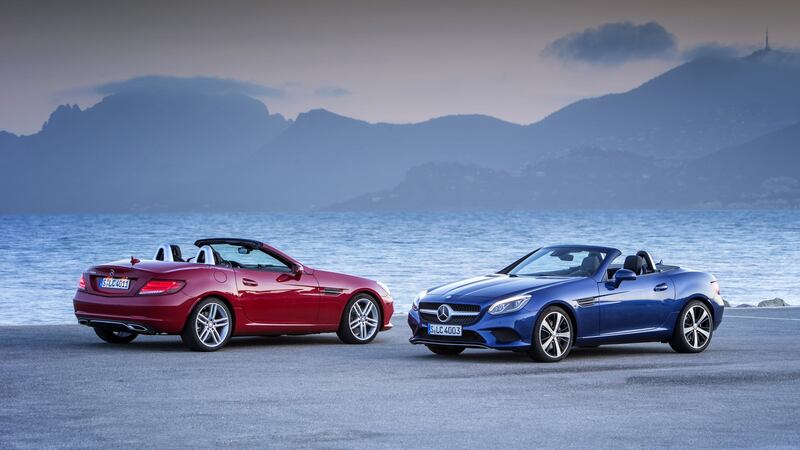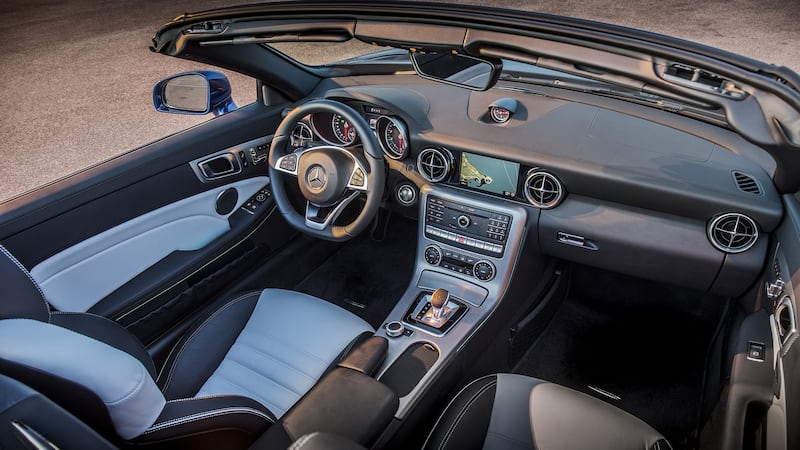The SLC is thought of within Mercedes as a sports car for hard-edged drivers, even though the rest of the automotive world knows those people either need to go down to the Mazda MX-5 or up to the Porsche Boxster. But there is still a place for the SLC in the landscape, given its unique combination of a folding hardtop, a comfortable ride and reasonable point-to-point pace.
Before you ask the obvious question, yes, this car used to be called the SLK. Pretty obvious, when you look at its short overhangs and sharp outline. After about 700,000 SLKs over the past 20 years, Mercedes-Benz has changed the name to the SLC, just so people know its two-seat convertible lines up with the C-Class.
The new version (a facelift, really) debuted at Detroit’s motor show in January and comes complete with everything from a Nissan-Renault-sourced 1.6-litre petrol four-pot in the SLC 180 to a turbocharged V6 in the AMG version.


The rest of the SLC family start with a 500Nm version of the 250d, with a 2.1-litre turbo
diesel family four, so that it has something to sell in the UK, through the 200 and 300 versions of the same 2.0-litre turbo petrol-powered four.
SLC 300 more fun
We’ve focused on the SLC 300 because, frankly, it seemed more fun than the diesel. The diesel was strong and surprisingly quick (getting to 100km/h in 6.6 seconds), but the lumpy noise of the Benz diesel (outmoded already by the E-Class’s new family diesel four) doesn’t neatly equate to roof-down driving, where you hear more of the motor than usual.
That’s not a problem with the 1,991cc four-cylinder petrol motor. It’s smooth and strong. With its 370Nm of torque arriving at only 1,300rpm, it has a diesel-style character in town and at low-engine speeds, while it still spins up to 6,000rpm, with the 180kW of power arriving at 5,500rpm.
That’s exactly 45kW more power and 75Nm more torque than the same engine delivers in the SLC 200, and you can assume those gaps have been arrived at over croissants and ginseng-laced cappuccinos at the marketing department, not stale sandwiches and a thermos across at engineering.
Obviously, the 300 is the quicker of the two, posting a 5.8-second sprint to 100km/h to head the 200 by 1.2 seconds.
Both the 300 and the 200 use the nine-speed family automatic gearbox, though the 200’s standard unit is a six-speed manual that is sadly unavailable on the faster model. The trade-off the other way, besides speed, is that the 300 has a standard sports exhaust, which is optional on the junior version of this power train.
Chassis
Beneath the skin, the chassis is almost unchanged, using some slight upgrades of the suspension in tuning.
While all SLC models come with the Dynamic Select button to switch the driving modes between Comfort, Sport, Sport+, Eco and Individual, an optional Dynamic handling package lowers the ride height another 10mm, adds adaptive dampers and ties them into Dynamic Select and sharper steering.
And that’s the package we walked into with the SLC 300. It might not be the cheapest point in the family, but it’s the sweet spot of the SLC range.
The roof now folds up or down at up to 40km/h and it has a light to warn you if the separator piece isn't locked into place to shrink the 335-litre boot space enough to give the roof's solid pieces somewhere to go. It also gets the air scarf, which blows warming air on to the necks of both occupants, which makes a comforting difference if you're climbing the Alps Maritimes in France.
It starts through an old-school twisting-key-in-the- ignition lock, but otherwise the interior is clean and crisp, if a little lacking in some of the more contemporary bits and pieces. The multimedia entertainment system has been upgraded, with a seven-inch display, internet access (only when stationary) and two USB ports. A new 4.5-inch TFT display screen now sits behind the traditional pair of tube dials, too.
For those paying less attention, the SLC facelift delivers Active Brake Assist as a standard tool, which can autonomously brake the car to reduce collision risk and severity.
It gets other tweaks, too, such as recognising when a child is in the front seat and automatically deactivating the passenger airbag, and having an optional reversing camera.
It’s an easy car to get comfortable in. There’s enough leg room for taller people and enough knee room for shorter folks, and the steering column is nicely centred, with a very straight-on driving position.
The engine starts smoothly and quietly, quickly settling into its idle even when it’s cold. And it was.
Unsung jewel
The nine-speed automatic is an unsung jewel in the new generation of Benzes, and it’s the same here. You pull the short lever into Drive and it slots unnoticed into gear, and it does almost the same thing every time it changes gear. Except in Sport mode.
Normally, in heavy traffic, the SLC 300’s power train is calm, smooth and unruffled. It’s strong at low engine speeds and it’s always ready to snap off another 100Nm to dive into a gap or to change lanes.
It uses the Magic Sky lights to go from a clear glass roof to an opaque dark blue one at the push of a button, which seems a bit pointless when you can just flip the roof back completely in a handful of seconds.
It’s a nicer machine again when you clear the traffic and move into the hills. Push along briskly and it seems at its best, with the gearbox naturally shifting into roughly the right gear by itself and the engine happy to work from the middle of its range upwards.
The balance is also there, with the car sweeping through faster bends in a convincing representation of something with a far longer wheelbase. It’s just nice; it’s a pleasant place to be.
But that changes. Push it harder, out to its limits of adhesion, and the exercise is too much for the chassis architecture, which bucks and jiggles, fighting the road in its efforts to keep the suspension working in the planes originally conceived by its engineers.
Flexing and wobbling
It does a reasonable job, but there’s too much flexing and wobbling going on, even if it is capable of generating some significant corner-to-corner pace.
The engine sings hard, the shifts snap up and down nicely in manual mode, but the ESP is a bit intrusive, limiting drive on corner exits (though its game can be lifted by switching it to a higher level).
It can flit from apex to apex, in slower and faster corners, with the sort of pace that would run with an MX-5, but it’s much harder work for far less driving reward. At the extremes, the movement of everything around you lets you know that you’re working the car beyond its comfort zone. Even if it manages the job without threatening to do anything nasty to you, it also never seems to be having as much fun as you’d like.
That’s why, despite Benz’s insistence that this is the sports car of choice in the Benz convertible armoury, it’s really not, and anybody after a true roofless sports-car experience needs to leave the brand.
But for those who are happy with slightly less, who don’t crave the sweetness of coherence you get from the best in the class, the SLC remains what the SLK always was: a roofless convertible two-seater for those who don’t drive very quickly most of the time.









